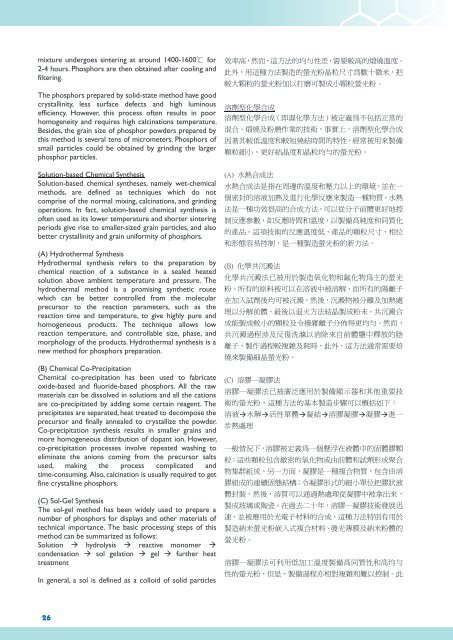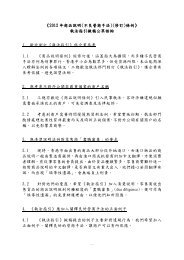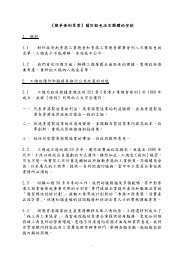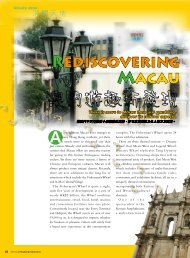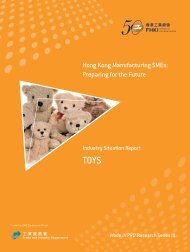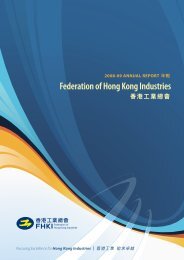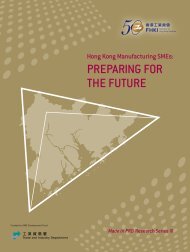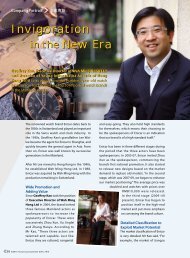利用稀土æå‡é¦™æ¸¯å‰µæ–°åŠç§‘技工æ¥çš„ç–ç•¥å¯è¡Œæ€§ç ”究 - 香港工æ¥ç¸½æœƒ
利用稀土æå‡é¦™æ¸¯å‰µæ–°åŠç§‘技工æ¥çš„ç–ç•¥å¯è¡Œæ€§ç ”究 - 香港工æ¥ç¸½æœƒ
利用稀土æå‡é¦™æ¸¯å‰µæ–°åŠç§‘技工æ¥çš„ç–ç•¥å¯è¡Œæ€§ç ”究 - 香港工æ¥ç¸½æœƒ
- No tags were found...
Create successful ePaper yourself
Turn your PDF publications into a flip-book with our unique Google optimized e-Paper software.
mixture undergoes sintering at around 1400-1600℃ for<br />
2-4 hours. Phosphors are then obtained after cooling and<br />
filtering.<br />
The phosphors prepared by solid-state method have good<br />
crystallinity, less surface defects and high luminous<br />
efficiency. However, this process often results in poor<br />
homogeneity and requires high calcinations temperature.<br />
Besides, the grain size of phosphor powders prepared by<br />
this method is several tens of micrometers. Phosphors of<br />
small particles could be obtained by grinding the larger<br />
phosphor particles.<br />
Solution-based Chemical Synthesis<br />
Solution-based chemical syntheses, namely wet-chemical<br />
methods, are defined as techniques which do not<br />
comprise of the normal mixing, calcinations, and grinding<br />
operations. In fact, solution-based chemical synthesis is<br />
often used as its lower temperature and shorter sintering<br />
periods give rise to smaller-sized grain particles, and also<br />
better crystallinity and grain uniformity of phosphors.<br />
(A) Hydrothermal Synthesis<br />
Hydrothermal synthesis refers to the preparation by<br />
chemical reaction of a substance in a sealed heated<br />
solution above ambient temperature and pressure. The<br />
hydrothermal method is a promising synthetic route<br />
which can be better controlled from the molecular<br />
precursor to the reaction parameters, such as the<br />
reaction time and temperature, to give highly pure and<br />
homogeneous products. The technique allows low<br />
reaction temperature, and controllable size, phase, and<br />
morphology of the products. Hydrothermal synthesis is a<br />
new method for phosphors preparation.<br />
(B) Chemical Co-Precipitation<br />
Chemical co-precipitation has been used to fabricate<br />
oxide-based and fluoride-based phosphors. All the raw<br />
materials can be dissolved in solutions and all the cations<br />
are co-precipitated by adding some certain reagent. The<br />
precipitates are separated, heat treated to decompose the<br />
precursor and finally annealed to crystallize the powder.<br />
Co-precipitation synthesis results in smaller grains and<br />
more homogeneous distribution of dopant ion. However,<br />
co-precipitation processes involve repeated washing to<br />
eliminate the anions coming from the precursor salts<br />
used, making the process complicated and<br />
time-consuming. Also, calcination is usually required to get<br />
fine crystalline phosphors.<br />
(C) Sol-Gel Synthesis<br />
The sol-gel method has been widely used to prepare a<br />
number of phosphors for displays and other materials of<br />
technical importance. The basic processing steps of this<br />
method can be summarized as follows:<br />
Solution hydrolysis reactive monomer <br />
condensation sol gelation gel further heat<br />
treatment<br />
In general, a sol is defined as a colloid of solid particles<br />
效 率 高 , 然 而 , 這 方 法 的 均 勻 性 差 , 需 要 較 高 的 煅 燒 溫 度 。<br />
此 外 , 用 這 種 方 法 製 造 的 螢 光 粉 晶 粒 尺 寸 為 數 十 微 米 , 把<br />
較 大 顆 粒 的 螢 光 粉 加 以 打 磨 可 製 成 小 顆 粒 螢 光 粉 。<br />
溶 劑 型 化 學 合 成<br />
溶 劑 型 化 學 合 成 ( 即 濕 化 學 方 法 ) 被 定 義 為 不 包 括 正 常 的<br />
混 合 、 煅 燒 及 粉 磨 作 業 的 技 術 , 事 實 上 , 溶 劑 型 化 學 合 成<br />
因 著 其 較 低 溫 度 和 較 短 燒 結 時 間 的 特 性 , 經 常 被 用 來 製 備<br />
顆 粒 細 小 、 更 好 結 晶 度 和 晶 粒 均 勻 的 螢 光 粉 。<br />
(A) 水 熱 合 成 法<br />
水 熱 合 成 法 是 指 在 周 邊 的 溫 度 和 壓 力 以 上 的 環 境 , 並 在 一<br />
個 密 封 的 溶 液 加 熱 及 進 行 化 學 反 應 來 製 造 一 種 物 質 。 水 熱<br />
法 是 一 種 功 效 很 高 的 合 成 方 法 , 可 以 從 分 子 前 體 更 好 地 控<br />
制 反 應 參 數 , 如 反 應 時 間 和 溫 度 , 以 製 備 高 純 度 和 同 質 化<br />
的 產 品 。 這 項 技 術 的 反 應 溫 度 低 、 產 品 的 顆 粒 尺 寸 、 相 位<br />
和 形 態 容 易 控 制 , 是 一 種 製 造 螢 光 粉 的 新 方 法 。<br />
(B) 化 學 共 沉 澱 法<br />
化 學 共 沉 澱 法 已 被 用 於 製 造 氧 化 物 和 氟 化 物 為 主 的 螢 光<br />
粉 。 所 有 的 原 料 被 可 以 在 溶 液 中 被 溶 解 , 而 所 有 的 陽 離 子<br />
在 加 入 試 劑 後 均 可 被 沉 澱 。 然 後 , 沉 澱 物 被 分 離 及 加 熱 處<br />
理 以 分 解 前 體 , 最 後 以 退 火 方 法 結 晶 製 成 粉 末 。 共 沉 澱 合<br />
成 能 製 成 較 小 的 顆 粒 及 令 摻 雜 離 子 分 佈 得 更 均 勻 。 然 而 ,<br />
共 沉 澱 過 程 涉 及 反 復 洗 滌 以 消 除 來 自 前 體 鹽 中 釋 放 的 陰<br />
離 子 , 製 作 過 程 較 複 雜 及 耗 時 , 此 外 , 這 方 法 通 常 需 要 焙<br />
燒 來 製 備 細 晶 螢 光 粉 。<br />
(C) 溶 膠 ─ 凝 膠 法<br />
溶 膠 ─ 凝 膠 法 已 被 廣 泛 應 用 於 製 備 顯 示 器 和 其 他 重 要 技<br />
術 的 螢 光 粉 , 這 種 方 法 的 基 本 製 造 步 驟 可 以 概 括 如 下 :<br />
溶 液 水 解 活 性 單 體 凝 結 溶 膠 凝 膠 凝 膠 進 一<br />
步 熱 處 理<br />
一 般 情 況 下 , 溶 膠 被 定 義 為 一 個 懸 浮 在 液 體 中 的 固 體 膠 顆<br />
粒 ; 這 些 顆 粒 包 含 緻 密 的 氧 化 物 或 由 前 體 和 試 劑 形 成 聚 合<br />
物 集 群 組 成 。 另 一 方 面 , 凝 膠 是 一 種 複 合 物 質 , 包 含 由 溶<br />
膠 組 成 的 連 續 固 態 結 構 ; 令 凝 膠 形 式 的 細 小 單 位 把 膠 狀 液<br />
體 封 裝 , 然 後 , 溶 質 可 以 通 過 熱 處 理 從 凝 膠 中 被 拿 出 來 ,<br />
製 成 玻 璃 或 陶 瓷 。 在 過 去 二 十 年 , 溶 膠 ─ 凝 膠 技 術 發 展 迅<br />
速 , 並 被 應 用 於 光 電 子 材 料 的 合 成 , 這 種 方 法 特 別 有 用 於<br />
製 造 納 米 螢 光 粉 嵌 入 式 複 合 材 料 、 發 光 薄 膜 及 納 米 粉 體 的<br />
螢 光 粉 。<br />
溶 膠 ─ 凝 膠 法 可 利 用 低 加 工 溫 度 製 備 高 同 質 性 和 高 均 勻<br />
性 的 螢 光 粉 , 但 是 , 製 備 過 程 亦 相 對 複 雜 和 難 以 控 制 。 此<br />
26


